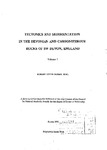Tectonics and sedimentation in the Devonian and carboniferous rocks of SW Devon, England.
| dc.contributor.author | Seago, Robert David | |
| dc.contributor.other | School of Geography, Earth and Environmental Sciences | en_US |
| dc.date.accessioned | 2011-09-26T15:20:05Z | |
| dc.date.available | 2011-09-26T15:20:05Z | |
| dc.date.issued | 1991 | |
| dc.identifier | Not available | en_US |
| dc.identifier.uri | http://hdl.handle.net/10026.1/723 | |
| dc.description | Merged with duplicate record 10026.1/2093 on 12.04.2017 by CS (TIS) | |
| dc.description.abstract |
Detailed mapping of the rocks to the north and south of Plymouth reveals a sedimentary sequence deformed by a series of folds and thrusts. Two structural zones exist each with a different style of deformation. In the Lower to Upper Devonian rocks of the southern zone, slip vectors, vergence and facing of D 1 folds indicate that the transport direction is to the north west. The northern zone, comprising Upper Devonian and lower Carboniferous strata, extends into central Devon and east Cornw~ll and the geometry and facing of the early folds in these rocks indicate a transport direction to the south or south east. Dl folds generally verge north but are downward facing towards the south. The two structural zones confront each other at an E-W trending line which passes through Cargreen to the north of Plymouth. The confrontation is interpreted as a northerly dipping backthrust produced by underthrusting of the Carboniferous foreland basin flysch deposits which become inverted and backthrust towards the south. The above sequence of events is dependent on a thin-skinned tectonic model and can be incorporated into the well established Early Carboniferous plate tectonic setting. Parameters indicating strike slip movement can also be incorporated within the envisaged thrust regime. These are thought to have been generated by differential movement related to the shape of the Variscan Front. The oblique trend of the Variscan Front to the regional transport direction observed in Southern Ireland, Wales and England, where it trends WNWESE, is thought to be a function of lateral buttressing against the Irish and LondonlBrabant Massifs during NW transport of thrust sheets. Re-mapping in the Plymouth area has also led to modifications of the Devonian stratigraphy and sedimentology of the Lower Devonian. The previously named Dartmouth Beds/Slates have been re-named the Dartmouth Group and comprise the Renney Rocks, Wembury, Yealm and Warren Formations. The latter pass upwards, by interdigitation, into the Meadfoot Group which in turn consists of the Bovisand and Staddon Grit Formations. Overlying the Meadfoot Group is the Plymouth Group which is divided into the Jennycliff Slate Formation, Plymouth Limestone Formation, Compton Slate Formation and the Saltram Slate Formation. The division of the previously named Plympton Formation into the two latter formations has allowed more control on structural mapping in the area north of Plymouth. The recognition of repeated stratigraphy and its further subdivision indicates that, due to thrusting, the sequences are much thinner than previously thought. The sedimentological character of the Dartmouth Group implies deposition in an alluvial setting and sub-environments include channels, sheetflow, overbank flow and lake deposition. Debris flows indicate that the area was periodically unstable. It is envisaged that deposition took place on a wet alluvial plain with rare drying out. The deposits probably represent a distal setting to the more proximal Old Red Sandstone alluvial deposits of South Wales. Higher up the sequence the Meadfoot Group records a major marine transgression across the area (Bovisand Formation) with a minor regressive pulse represented by the Staddon Grit Formation. The boundary conditions of these two formations has been examined and the sedimentology of this part of the sequence indicates the presence of a series of offshore bar forms. They are thought to represent mouth bar sequences related to the overlying deltaic sequence of the Staddon Grit Formation. Analysis of the onshore New Red Sandstone indicates the presence of a topographic high in the Start area. This local palaeogeographic detail can be related to the regional offshore Permian Basin form. | en_US |
| dc.language.iso | en | en_US |
| dc.publisher | University of Plymouth | en_US |
| dc.title | Tectonics and sedimentation in the Devonian and carboniferous rocks of SW Devon, England. | en_US |
| dc.type | Thesis | |
| dc.identifier.doi | http://dx.doi.org/10.24382/3374 | |
| dc.identifier.doi | http://dx.doi.org/10.24382/3374 |
Files in this item
This item appears in the following Collection(s)
-
01 Research Theses Main Collection
Research Theses Main



